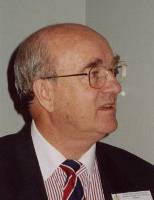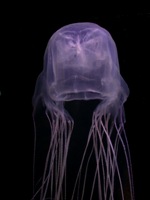


Venomous Country
Participants
Venomous Country
Endnotes
Index
Search
Help
Contact us

Ken Winkel: John, and John, your first memories of Struan and knowledge of his activities.
John Pearn[33]: I guess my first memories of Struan were as a young registrar at the Royal Children's Hospital in Brisbane, handling clinical snake bites. Until Struan really got going at CSL - this is my memory talking - the advice about snake bite was really on the old boy network, usually with telephone advice from various local experts. Most people handling snake bites in Australia knew somebody locally, whether one was working in Melbourne, Adelaide, Perth or Brisbane. But from 1967 or 1968, Struan - who had been at CSL then for some years - was already being sought for advice by interstate telephone callers.

Photograph courtesy of Ann Westmore
I can remember ringing him when I was a young registrar handling a difficult snake bite at the Brisbane Children's Hospital. Gradually, from about that time, his reputation as the national consultant grew. One of the great strengths of Struan's personality was he was always available at the end of the phone. He used to say explicitly, "Ring me at any time of the day or night". I am sure Susie remembers the phone going day and night. I would suspect that a day never went by without somebody ringing him from somewhere around Australia, certainly by the 1970s.
My military career started in 1965, and that was the last year of Struan's infamous time in the Navy. His reputation as a naval surgeon was around the corridors at that stage. Struan must have been a nightmare to the "military machine". He was such an individual, so contemptuous of any authority which was not underpinned by wisdom. And his own words, his slightly combative personality, and his fearlessness in making fun of anybody who was a bit pompous didn't sit well with his time in the Navy. His reputation was still around the corridors in the mid-1960s. Those perhaps of a more senior Naval rank had been stung by his fearless laughter, his irony and playful mischievousness and occasional sarcasm.
I remember him from those days as one who was always very helpful and there was never any embarrassment about ringing him through the night from all sorts of strange places. I can remember ringing him in 1966 from the Sepik district of Papua New Guinea where I was a young doctor-soldier in the "Confrontation" at that time when Indonesia was reaching out belligerently against Malaya, the state of Singapore, and Australia. A number of young Australian doctors went out, serving in the Sepik district where there were a very significant number of snake bites. And I can remember him, at that stage, always being available on the radio telephone.
John Williamson[34]: Thank-you, Ken. I had on one occasion to pick Struan up at a Gold Coast Hospital because we were having a small venom meeting on the Gold Coast some years ago, and I was delayed about 20 minutes. I knocked on the door and he said, 'Come in.' I said, 'I'm sorry Struan, I was held up.' He replied, 'John, it's quite all right. I'm never bored with my own company.'
Now, Robert will probably know the story of the jumper ants better than I will, but Struan told it to us. This was the then problem of extracting the little venom sacs from the ants. He called an expert from somewhere in Melbourne. I have no idea who it was or where it was and perhaps this person is present, so I'd better be careful! After a couple of hours of very careful dissection under a low power microscope, the actual little sac was obtained but the venom had been lost in the process. And this was only one ant. So the expert went away. And Struan took the next ant, looked down the microscope, grabbed the sac, pulled and announced in triumph, holding the intact venom sac aloft, 'There it is!' He always had such a very direct approach. And I agree with John, Struan was a disciple of the truth. And I think that's how we should be here today. Because if he was here now, that's just what he would want.
I should like to point out that one of the interesting influences on the whole venom and antivenom story was the geography of Australia, the long distances between where many of us actually were ploughing around trying to find answers and using Struan's brains. But also I have to say that we all suffered and still suffer from parochialism a bit. For example, with greatest respect, people who've lived and had all their careers here in Melbourne don't have a good handle on what goes on in North Queensland and vice-versa. This is one of the features of the human condition and also of our nation. But it's made for some very interesting evolutions. Struan was well aware of this, and as John says, you could ring him up any time of the day or night and get really sensible answers at 2 a.m. which, as a 24-hour anaesthetist, that impressed me. It used to happen to me, and it's not always easy to snap to attention at 3 a.m., especially when you went to bed at 1 a.m. But Struan did it for many years.
Now, in the 1960s, deaths following stings from cubozoan or 'box-shaped' jellyfish in North Queensland had reached such a pass that the survival of Surf Life Saving Queensland north of Gladstone was seriously jeopardised. Dr Jack Barnes in Cairns was at work and, as you will remember, he was at that stage using methylated spirits as the dousing solution to inhibit nematocyst discharge in major box-jellyfish stings.[35] Here I'm referring specifically to Chironex fleckeri, the multi-tentacled box-jellyfish.[36]

Struan was well aware of this and Jack, of course, in his innovative way, had been studying the microscopic features of nematocyst. He conceived the idea of increasing the distance from the fresh tentacle to the blood-bearing sub-dermal tissues where the venom is deposited from each discharging nematocyst. He wasn't clear about the trajectory distance of the nematocyst and he wanted some expert knowledge. So he rang Struan up. Now I don't have first-hand knowledge of this, but this is what Jack told me. He asked Struan about the concept of wearing something on the skin to increase this distance. Struan thought this was a really good idea. It was Jack's idea but Struan said it's worth a try. That led to Jack wearing pantyhose, as you know. And Jack wore pantyhose and in his typical fashion went into the sea in Cairns and stung himself with a very large adult box jellyfish - there are sixty tentacles on these animals, bearing thousands of millions of venom-bearing nematocysts. He laid the animal and tentacles across his thighs and, although he felt a little tingling, he didn't suffer any harmful effects. This is actually all filmed and is retained within the Archives of Surf Life Saving Queensland, in Brisbane.
 |
Witness to the History of Australian Medicine |  |
© The University of Melbourne 2005-16
Published by eScholarship Research Centre, using the Web Academic Resource Publisher
http://witness.esrc.unimelb.edu.au/077.html